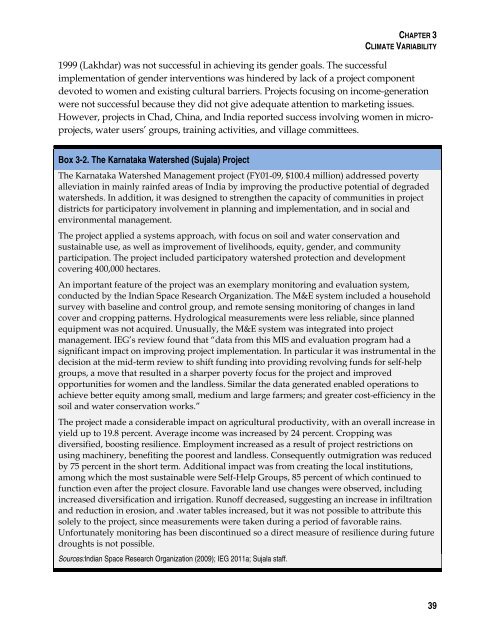Adapting to Climate Change: Assessing the World Bank Group ...
Adapting to Climate Change: Assessing the World Bank Group ...
Adapting to Climate Change: Assessing the World Bank Group ...
Create successful ePaper yourself
Turn your PDF publications into a flip-book with our unique Google optimized e-Paper software.
CHAPTER 3CLIMATE VARIABILITY1999 (Lakhdar) was not successful in achieving its gender goals. The successfulimplementation of gender interventions was hindered by lack of a project componentdevoted <strong>to</strong> women and existing cultural barriers. Projects focusing on income-generationwere not successful because <strong>the</strong>y did not give adequate attention <strong>to</strong> marketing issues.However, projects in Chad, China, and India reported success involving women in microprojects,water users’ groups, training activities, and village committees.Box 3-2. The Karnataka Watershed (Sujala) ProjectThe Karnataka Watershed Management project (FY01-09, $100.4 million) addressed povertyalleviation in mainly rainfed areas of India by improving <strong>the</strong> productive potential of degradedwatersheds. In addition, it was designed <strong>to</strong> streng<strong>the</strong>n <strong>the</strong> capacity of communities in projectdistricts for participa<strong>to</strong>ry involvement in planning and implementation, and in social andenvironmental management.The project applied a systems approach, with focus on soil and water conservation andsustainable use, as well as improvement of livelihoods, equity, gender, and communityparticipation. The project included participa<strong>to</strong>ry watershed protection and developmentcovering 400,000 hectares.An important feature of <strong>the</strong> project was an exemplary moni<strong>to</strong>ring and evaluation system,conducted by <strong>the</strong> Indian Space Research Organization. The M&E system included a householdsurvey with baseline and control group, and remote sensing moni<strong>to</strong>ring of changes in landcover and cropping patterns. Hydrological measurements were less reliable, since plannedequipment was not acquired. Unusually, <strong>the</strong> M&E system was integrated in<strong>to</strong> projectmanagement. IEG’s review found that “data from this MIS and evaluation program had asignificant impact on improving project implementation. In particular it was instrumental in <strong>the</strong>decision at <strong>the</strong> mid-term review <strong>to</strong> shift funding in<strong>to</strong> providing revolving funds for self-helpgroups, a move that resulted in a sharper poverty focus for <strong>the</strong> project and improvedopportunities for women and <strong>the</strong> landless. Similar <strong>the</strong> data generated enabled operations <strong>to</strong>achieve better equity among small, medium and large farmers; and greater cost-efficiency in <strong>the</strong>soil and water conservation works.”The project made a considerable impact on agricultural productivity, with an overall increase inyield up <strong>to</strong> 19.8 percent. Average income was increased by 24 percent. Cropping wasdiversified, boosting resilience. Employment increased as a result of project restrictions onusing machinery, benefiting <strong>the</strong> poorest and landless. Consequently outmigration was reducedby 75 percent in <strong>the</strong> short term. Additional impact was from creating <strong>the</strong> local institutions,among which <strong>the</strong> most sustainable were Self-Help <strong>Group</strong>s, 85 percent of which continued <strong>to</strong>function even after <strong>the</strong> project closure. Favorable land use changes were observed, includingincreased diversification and irrigation. Runoff decreased, suggesting an increase in infiltrationand reduction in erosion, and .water tables increased, but it was not possible <strong>to</strong> attribute thissolely <strong>to</strong> <strong>the</strong> project, since measurements were taken during a period of favorable rains.Unfortunately moni<strong>to</strong>ring has been discontinued so a direct measure of resilience during futuredroughts is not possible.Sources:Indian Space Research Organization (2009); IEG 2011a; Sujala staff.39

















